Professional wrestling holds include a number of set moves and pins used by performers to immobilize their opponents or lead to a submission. This article covers the various pins, stretches and transition holds used in the ring. Some wrestlers use these holds as their finishing maneuvers, often nicknaming them to reflect their character or persona. Moves are listed under general categories whenever possible.

Masahiko Kimura was a Japanese judoka and professional wrestler who is widely considered the greatest judoka of all time. He won the All-Japan Judo Championships three times in a row for the first time in history and had never lost a judo match from 1936 to 1950. In submission grappling, the reverse ude-garami arm lock is often called the "Kimura", due to his famous victory over Gracie jiu-jitsu co-founder Hélio Gracie. In the Japanese professional wrestling world, he is known for being one of Japan's earliest stars and the controversial match he had with Rikidōzan.
A triangle choke, or sankaku-jime (三角絞) in judo, is a type of figure-four chokehold that encircles the opponent's neck and one arm with the legs in a configuration similar to the shape of a triangle. Applying pressure using both legs and the opponent's own shoulder, the technique is a type of lateral vascular restraint that constricts the blood flow from the carotid arteries to the brain, potentially resulting in loss of consciousness in seconds when applied correctly. Recent studies have shown that the triangle choke takes an average of 9.5 seconds to render an opponent unconscious from the moment it is properly applied.

The mount, or mounted position, is a dominant ground grappling position, where one combatant sits on the other combatants torso with the face pointing towards the opponent's head. This is a favorable position for the top combatant in several ways. The top combatant can generate considerable momentum for strikes to the head of the opponent, while the bottom combatant is restricted by the ground and by the combatant on top. Other advantages include various chokeholds and joint locks that can be applied from the top. The bottom combatant will usually look to sweep the opponent or transition into a better position such as the guard.
A leglock is a joint lock that is directed at joints of the leg such as the ankle, knee or hip joint. A leglock which is directed at joints in the foot is sometimes referred to as a foot lock and a lock at the hip as a hip lock. Leglocks are featured, with various levels of restrictions, in combat sports and martial arts such as Sambo, Brazilian Jiu-Jitsu, catch wrestling, mixed martial arts, Shootwrestling and submission wrestling, but are banned in some sports featuring joint locks such as judo. The technique has been seen across a wide range of different combat sports and is reportedly over 2,500 years old, having been seen in the lost art of Pankration in the original Olympic Games.

A grappling hold, commonly referred to simply as a hold that in Japanese is referred to as katame-waza, is any specific grappling, wrestling, judo, or other martial art grip that is applied to an opponent. Grappling holds are used principally to control the opponent and to advance in points or positioning. The holds may be categorized by their function, such as clinching, pinning, or submission, while others can be classified by their anatomical effect: chokehold, headlock, joint-lock, or compression lock. Multiple categories may be appropriate for some of these holds.
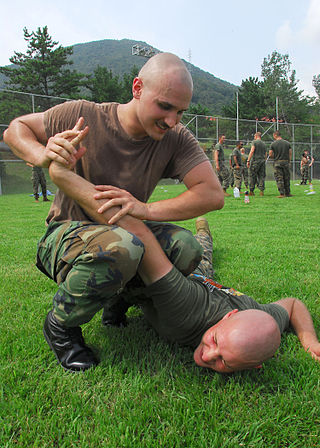
A wristlock is a joint lock primarily affecting the wrist-joint and, in some cases, the radioulnar joints through rotation of the hand. A wristlock is typically applied by grabbing the opponent's hand, and bending and/or twisting it. Wristlocks are very common in martial arts such as chin-na, aikido, hapkido and jujutsu where they are featured as self-defense techniques. They are also used as submission holds in martial arts such as Brazilian jiu-jitsu and catch wrestling. While being an illegal technique in modern sambo and judo competitions, it is still practiced in judo forms of self-defense kata kōdōkan goshinjutsu. Wristlocks are also widely used as pain compliance holds, often in police, military, and residential treatment centers.

Knee-on-stomach, or knee-on-belly, knee-on-chest, knee-ride, knee mount, is a dominant ground grappling position where the top combatant places a knee on the bottom combatant's torso, and usually extends the other leg to the side for balance. This position is typically obtained from side control, simply by rising up slightly and putting a knee on the opponent's stomach or chest.
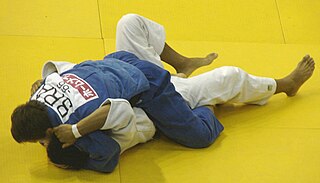
Tate-Shiho-Gatame (縦四方固) is one of the seven mat holds, Osaekomi-waza, of Kodokan Judo. In grappling terms, it is categorized as a mounted position.

Ude-Hishigi-Juji-Gatame (腕挫十字固) is one of the official 29 grappling techniques of Kodokan Judo. It is one of the nine joint techniques of the Kansetsu-waza list, one of the three grappling lists in Judo's Katame-waza enumerating 29 grappling techniques. All of Judo's competition legal joint techniques are arm locks.
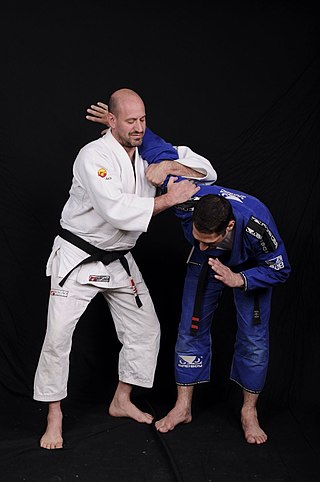
Ude-Hishigi-Ude-Gatame (腕挫腕固) is one of the official 29 grappling techniques of Kodokan Judo. It is one of the nine joint techniques of the Kansetsu-waza list, one of the three grappling lists in Judo's
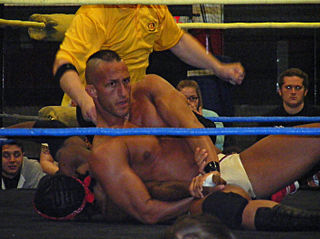
Ude-Hishigi-Waki-Gatame is an armlock and one of the official 29 grappling techniques of Kodokan Judo. It is one of the nine joint techniques of the Kansetsu-waza list, one of the three grappling lists in Judo's Katame-waza enumerating 29 grappling techniques. Falling directly to the mat while applying or attempting to apply the Waki gatame in competition is listed as an hansoku make by the International Judo Federation.
Ude-Hishigi-Te-Gatame (腕挫手固) is one of the official 29 grappling techniques of Kodokan Judo. It is one of the nine joint techniques of the Kansetsu-waza list, one of the three grappling lists in Judo's Katame-waza enumerating 29 grappling techniques.

Ude-Hishigi-Sankaku-Gatame (腕挫三角固), also referred to as Ao muke gata ude hishigi (背中方腕挫) in the Canon Of Judo, is one of the official 29 grappling techniques of Kodokan Judo. It is one of the nine joint techniques of the Kansetsu-waza list, one of the three grappling lists in Judo's Katame-waza, enumerating 29 grappling techniques, and is also demonstrated by Kyuzo Mifune in the video The Essence of Judo.
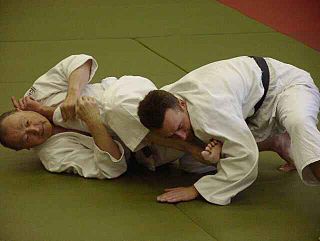
Ude-Hishigi-Hiza-Gatame (腕挫膝固) is one of the official 29 grappling techniques of Kodokan Judo. It is one of the nine joint techniques of the Kansetsu-waza list, one of the three grappling lists in Judo's Katame-waza enumerating 29 grappling techniques.
Aikido techniques are frequently referred to as waza 技. Aikido training is based primarily on two partners practicing pre-arranged forms (kata) rather than freestyle practice. The basic pattern is for the receiver of the technique (uke) to initiate an attack against the person who applies the technique—the 取り tori, or shite 仕手, also referred to as (投げ nage, who neutralises this attack with an aikido technique.




















